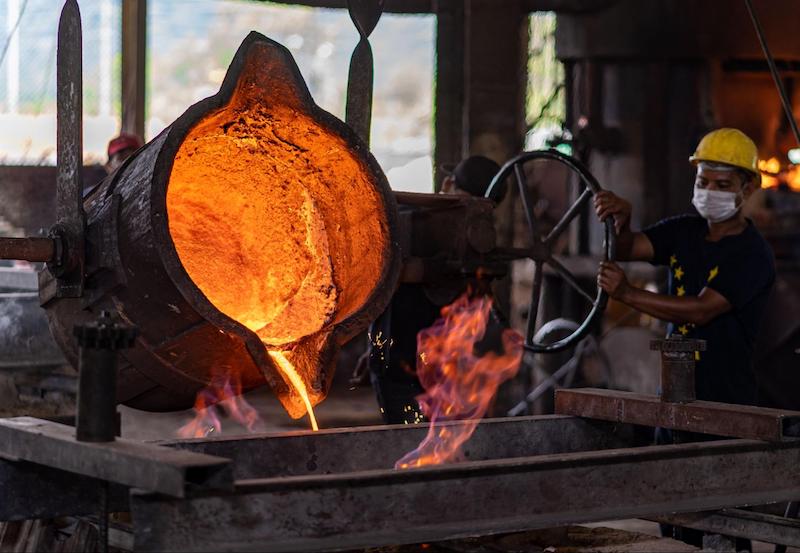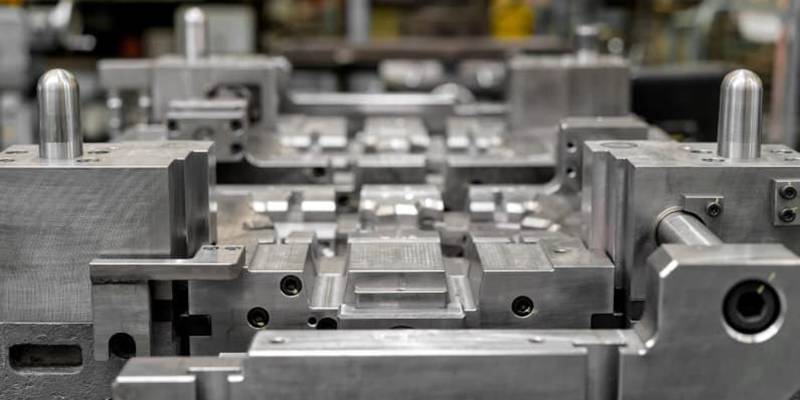The Ultimate Guide to Metal Castings and Their Long-Term Cost Benefits
Wiki Article
A Comprehensive Guide to the Perks of Utilizing Aluminum From Foundries
Aluminum from foundries provides a variety of advantages that make it an important material throughout various sectors. Its light-weight nature adds to cost financial savings in transport and improves total product effectiveness. Furthermore, aluminum's remarkable resistance to rust assurances longevity and reduces upkeep requirements. Nonetheless, the benefits expand beyond these aspects (Aluminum Foundry). Comprehending the complete spectrum of aluminum's properties and their implications can reveal also much deeper insights into its duty in contemporary applicationsUnderstanding Foundry-Grade Aluminum
Foundry-grade aluminum is a specialized product renowned for its extraordinary buildings and versatility in numerous applications. This sort of aluminum is generally generated via regulated spreading procedures, permitting for exact control over its make-up and microstructure. Because of this, foundry-grade aluminum exhibits remarkable mechanical homes, consisting of excellent toughness and rust resistance, making it suitable for requiring settings.In enhancement to its structural stability, foundry-grade aluminum can be conveniently built right into complicated shapes, giving designers and designers with adaptability in their jobs. Its capability to withstand heats additionally enhances its appeal for markets such as vehicle and aerospace, where efficiency and integrity are critical. In addition, foundry-grade aluminum is typically recyclable, contributing to sustainability efforts. By utilizing this product, suppliers can attain an equilibrium of performance, resilience, and environmental obligation, making foundry-grade aluminum a favored choice for a variety of industrial applications.
Lightweight Characteristics and Their Advantages
The light-weight homes of aluminum from foundries supply substantial advantages in various applications. Reduced transport expenses can be achieved due to the reduced weight, enabling much more effective logistics. Furthermore, the enhanced item efficiency stemmed from utilizing lighter materials can lead to boosted performance and user experience.Decreased Transportation Prices
Aluminum's light-weight homes significantly contribute to reduced transportation prices, making it an eye-catching choice for numerous industries. When compared to heavier materials such as steel, aluminum permits lighter tons, enabling cars to transport more products successfully. This decrease in weight can lead to considerable cost savings on fuel usage, as lighter vehicles call for much less energy to operate. In addition, the ability to transfer bigger quantities without exceeding weight limits enhances logistical efficiency. Industries such as automotive and aerospace benefit particularly from these benefits, as they can maximize shipping processes and lower total functional expenses. Consequently, making use of aluminum from foundries not only streamlines transport however additionally supports sustainable methods by lessening carbon discharges linked with hefty freight transportation.Enhanced Product Efficiency

Rust Resistance: A Trick Advantage
Aluminum from foundries provides outstanding rust resistance, mostly because of its natural oxide layer. This safety finishing types when aluminum is revealed to air, protecting against further oxidation and damage. Consequently, items made from aluminum can show lasting durability, making them excellent for different applications in tough settings.Natural Oxide Layer
The all-natural oxide layer that develops on aluminum surfaces works as an essential defense versus deterioration. This slim, clear obstacle develops when aluminum is exposed to oxygen, successfully securing the underlying steel from different environmental variables. The oxide layer is both secure and durable, ensuring that aluminum maintains its stability over time. Unlike other steels that might corrode much more rapidly, aluminum's oxide layer avoids the development of corrosion and various other damaging compounds. This characteristic is especially useful in industries where products are subjected to moisture or severe chemicals. Consequently, the presence of the natural oxide layer adds considerably to the long life and integrity of aluminum products, making it a recommended choice in many applications.Durable Sturdiness
While many materials succumb to the ravages of time and environmental exposure, the durable sturdiness of aluminum stands out, primarily due to its remarkable deterioration resistance. This resistance is associated to a natural oxide layer that bases on its surface, efficiently securing the metal from wetness, chemicals, and various other corrosive representatives. Unlike view steel, which can rust and degrade over time, aluminum stays undamaged, making it excellent for numerous applications, including building, vehicle, and aquatic markets. Its light-weight nature, integrated with longevity, permits decreased upkeep prices and longer life expectancies in products. Consequently, aluminum from foundries offers a lasting choice that decreases replacement frequency, adding to both economic performance and environmental responsibility. This durability enhances its appeal in numerous applications.The Recyclability of Aluminum
Given its considerable usage across different sectors, the recyclability of aluminum presents a substantial environmental benefit. Aluminum can be reused indefinitely without shedding check this its properties, making it a prime prospect for sustainable techniques. The recycling procedure calls for only a portion of the energy needed to produce new aluminum from raw materials, lowering greenhouse gas exhausts and conserving natural deposits. Additionally, the recycling of aluminum draws away waste from land fills, adding to much more efficient waste administration systems.
Cost-Effectiveness in Numerous Applications
Many industries acknowledge aluminum's cost-effectiveness, making it a favored option for different applications. Its light-weight nature reduces transportation prices and power intake, substantially adding to overall savings. In production, aluminum's pliability permits reliable shaping and creating, reducing waste throughout manufacturing.Moreover, aluminum's sturdiness warranties durability, which minimizes the need for constant replacements and maintenance. The article product's deterioration resistance additionally equates right into reduced long-lasting prices, as it calls for less protective layer and care compared to various other steels.

Sustainability and Environmental Influence
Aluminum's cost-effectiveness is enhanced by its sustainability and positive environmental effect. The steel is highly recyclable, with roughly 75% of all aluminum created still in operation today. This recyclability substantially minimizes the demand for basic material removal, decreasing power usage and connected greenhouse gas discharges. Foundries play an important function in the reusing procedure, making use of sophisticated technologies to repurpose scrap aluminum efficiently.Aluminum manufacturing from recycled product eats just around 5% of the energy required for key aluminum manufacturing. This considerable energy cost savings equates to decrease carbon impacts, aligning with international sustainability goals. In addition, aluminum's lightweight nature boosts gas efficiency in transportation applications, better adding to minimized emissions throughout its lifecycle. As sectors progressively prioritize lasting techniques, aluminum from foundries becomes a favorable option, promoting environmental stewardship while supporting financial development.
Regularly Asked Inquiries
What Are the Typical Applications of Foundry-Grade Aluminum?
Typical applications of foundry-grade aluminum consist of automotive parts, aerospace parts, equipment, building products, and consumer items. Its lightweight nature, corrosion resistance, and excellent mechanical residential properties make it appropriate for varied sectors and manufacturing processes.Just How Is Foundry-Grade Aluminum Produced?
Foundry-grade aluminum is generated via melting aluminum scrap or ingots, adhered to by alloying with various other steels. The molten aluminum is then cast into molds, enabling it to solidify into different shapes for diverse applications.What Are the Safety Factors To Consider When Collaborating With Aluminum?
Safety considerations when functioning with aluminum consist of proper ventilation to prevent inhaling dirt, use personal safety devices to prevent skin contact, and understanding of fire threats connected with liquified aluminum throughout handling and spreading.Exactly How Does Foundry-Grade Aluminum Compare to Other Metals?
Foundry-grade aluminum provides a superior strength-to-weight proportion contrasted to lots of metals, along with superb deterioration resistance and thermal conductivity. Its adaptability and ability to be quickly formed make it a favored option in numerous applications.What Maintenance Is Needed for Aluminum Products?
Aluminum products require very little maintenance, mostly including normal cleaning to stop oxidation and dirt build-up (Aluminum Foundry). Protective finishes may boost toughness, while periodic evaluations can assure architectural stability and attend to any kind of wear or damage immediatelyFoundry-grade aluminum is a specific product renowned for its extraordinary residential or commercial properties and adaptability in numerous applications. Leveraging lightweight residential properties, aluminum improves item efficiency throughout various applications. Unlike steel, which can rust and degrade over time, aluminum stays undamaged, making it optimal for different applications, consisting of building, vehicle, and aquatic industries. Aluminum manufacturing from recycled material consumes just around 5% of the power required for primary aluminum manufacturing. Foundry-grade aluminum is produced with melting aluminum scrap or ingots, adhered to by alloying with other metals.
Report this wiki page